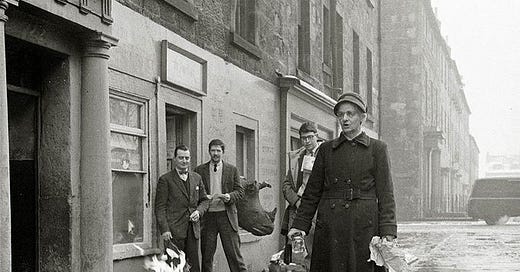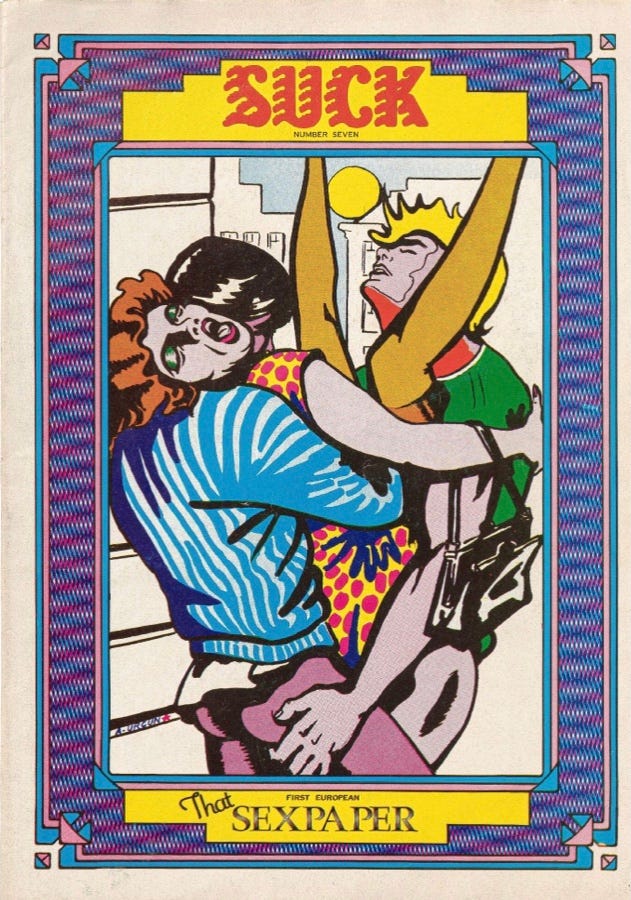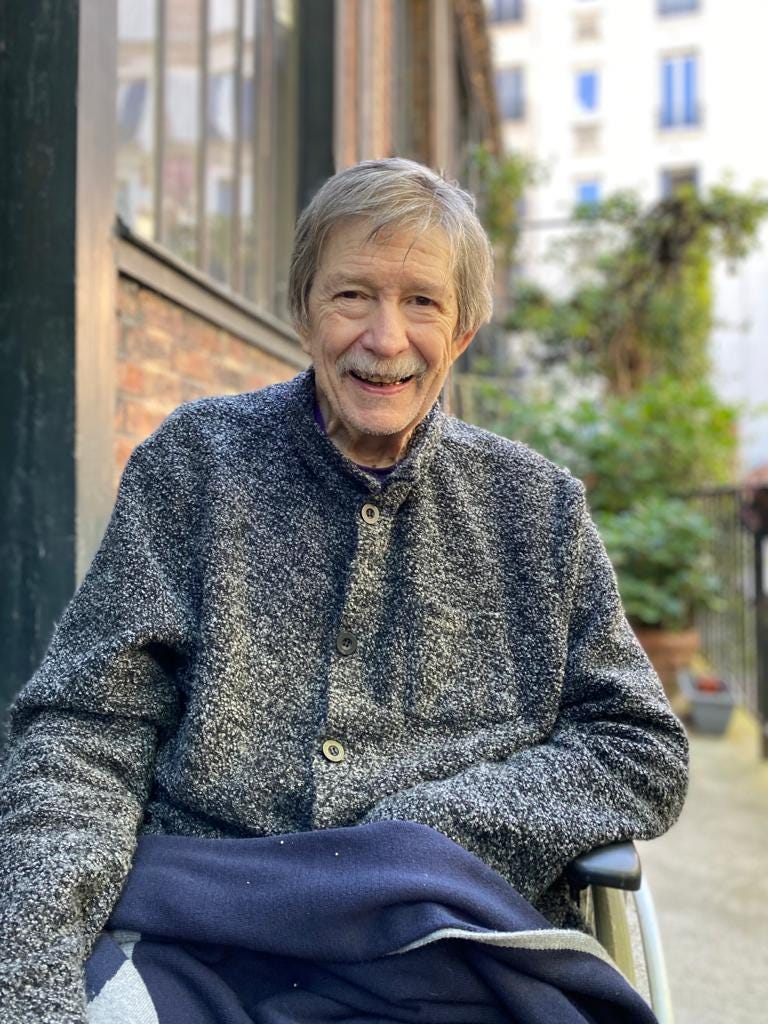Performance outside the Paperback bookshop, Edinburgh, 1960.
«Without imposing himself on events, acted as he wished to live and so doing drew people into his circle. An example of living rather than of great men.» John Lloyd
Sitting in Jim Haynes’ kitchen at this present hour on a cool Thursday morning, strangely enough, I find only Carl up and about, asking me if I want anything to drink. No sleepy heads on the sofa, nobody trundling downstairs to pick up where they left off, no cries of joy or hangover groans from the loft upstairs. The books are neatly lined along the wall and the melancholy, fearful woman in the passage shelters from the rain, her eyes, as always, on the clouds. Raining coming, always more rain sooner or later. Where’s the party ? Is it really so very early ? Where’s Jim ?
Haynes’s place is on a lush alley hidden behind a massive metal door off Tombe d’Issoire in the southern 14th Arrondissement. Paris reveals itself so slowly. You’re always behind, you’re always struggling to add more data to the picture, like a point in one of the meticulous paintings by Seurat. Who the hell was Issoire, who fell and is buried there ? It took me years to find out and then only by chance. Isoré was a medieval giant, a freak of nature who towered over the French pilgrims leaving Paris en route to Orleans for the trek to Compostela. The man-beast frightened the faithful, robbed them at will and ate them for dinner, giving the ones who escaped a nightmare start to their journey, something out of an old fable. And now that I know that fancy piece of information, it turns out that no one in Paris cares because Isoré, latterly dressed up to Issoire, gets no reaction from anybody.
Villa Seurat is next door. Everybody lived there, from Gromaire to Couturier to Hart Crane to Madame Bertrand to Thiriet to Chana Orloff, not forgetting a certain H. Miller, who barged into people’s apartments complaining about the lack of heat – his way of introducing himself. Everyone who was anyone left some trace behind, except Georges Seurat, dead at 31, who was busy painting a dozen much-mocked canvases which altered the way we see the world.
Sitting in this kitchen, in all likelihood, means nothing to you in the States but it means a great deal to Parisians of many ages, and fair to say, a life-saving many things to travelers all over the world, who must evade giants and make friends.
I took precautions. No sense walking in to a houseful of strangers without knowing whether I’m carrying the virus or not. Of course, maybe I picked it up on the way over, after the test, pressed against the downcast, masked faces on the tram. We may be rotting from the inside but we’ve got our certificates of health.
So who was Jim Haynes ? The Man Who Knew Everybody ? Do I proceed with facts ? What good are they when talking about a human life where facts are always in dispute, when it’s the penumbra, the aura, the way of being, anyone’s particular grace that draws people, that makes a man or woman important, giving us a reason to love that person or be around him or her. Jim had many who idolized him, even if, from here, sitting in this nearly empty kitchen with its generous ceiling, the long table receding to infinity and its couches, at this moment, bereft of the happy crowds who filled the room on Sunday evenings, as I look at photos and books and call up the memory of people we knew in common, Ricky Demarco and John Calder, the room feels like a cold church on a Thursday afternoon, before the organist gets his practice licks in. But one is living and it is always different, and here I am, semi-sober and disease free on Thursday morning. Who knew it would come to this ?
—Sugar ?
(Jim Haynes : a man whom I cannot precisely, honestly say I knew so very well. He remains, at his core, a mystery. How do we proceed ? «Jim Haynes, a genial soul who simultaneously gave everything and nothing away.» Or maybe like the TV announcer, who in his crisp English coughs down the hallways of eternity, « To those tens of thousands who talked or stayed or slept with Jim Haynes he is simply a legend…» Like that ? Scratching noises begin on the Bristol pad I take everywhere.)
—You’ll want to see that film, won’t you ?
Born ’33 in Haynesville, not so far from Shreveport and Texarkana, Louisiana. El Dorado is across the border, with a town named Smackover nearby. 8th and 9th grades in Venezuela, where he’s voted the best liked boy in a school full of oil-company kids and learns to dance in the local bordellos. Haynesville is north Louisiana and the population is balanced between black and white, far from the penitentiary bayous further south.
Skip a few years and the scene changes dramatically : ’56, just after the invasion of Hungary, Jim Haynes arrives at the U.S. military base in Kirknewton, Scotland, a shake of the head outside Edinburgh. By ’59 he’s opened The Paperback, a bookstore adorned with an abandoned rhino head, where he sold contraband copies of Lady Chatterly’s Lover from the States, Evergreen magazine and other editions published by one Barney Rosset. A prim old dame stops in and asks about the smutty book and Jim obligingly directs her to it. Returning twenty minutes later, she uses a pair of tongs to carry Lawrence’s masterpiece outside and while delivering a lecture on lechery and damnation, sets the book on fire. The bookstore has its baptism and becomes a roaring success, hosting plays such as Ubu Roi and Orpheus Descending in their UK debuts. Nathalie Sarraute and Margeurite Duras arrive, led by their English language publisher John Calder. The Revolution is on, so Haynes and Calder propose a literary adjunct to the staid Edinburgh Festival. The festival is Edina’s postwar summer event, mainly classical music and theatre. It’s safe to say the town fathers had no idea what was about to hit them.
Edna O’Brien, Henry Miller, William Burroughs (all three honored by being banned in their home countries), Norman Mailer and Mary McCarthy descend on the snobby Scottish culture capital for the Writers Conference in the summer of ’62, that, if not the first, sets the scene for overflowing, mad festivals to come, 80 writers giving talks every week, parties night after night. Breyten Breytenbach has his first show of paintings at The Paperback (a Nobel Prize comes later) and Yevgeny Yevtushenko gets a big dinner. The world is changing at supersonic speed, and while Mailer bangs the podium with one of his patented, nearly incomprehensible rants, the spotlight is on Burroughs and Miller, two cranks come in from the cold to a warm reception. Outsiders are in, and suddenly, anything is possible. Egged on by the lead actress in Orpheus, one Jane (Quigley) Alexander, who tells him, ‘Your life cannot be real without theater,’ and his friend the cheerful, energetic gnome Ricky Demarco, the Traverse Theatre is born. January ’63 sees the first production and that same summer a Drama Conference on the ‘Future of the Theater’ is organized by Kenneth Tynan, John Calder and Haynes. Good company, no ? When I was kicking around town a decade ago, Demarco was there, as energetic as ever, with a gallery dedicated to the history of their theatrical exploits.
That would be enough done for most people but the tide was high and Haynes followed it, to London where in ’66 he co-founds the International Times, harbinger of the underground press to come. They are quickly printing editions of 40,000 every two weeks. Events are happening, not least because Alan Kaprow and others went to Edinburgh to show them how. Haynes ran the London Arts Lab, an extension of his theatre work, from ’66 to ’69, where, in the words of the playwright Steven Berkoff, « Every eccentric maverick lunatic individualist came to lay his egg.» A visiting John and Yoko sit down for an interview with German TV and the next day the place is crawling with Central European hippies. Bye bye, Arts Lab.
Of course it’s Haynes’ legendary hospitality, his willingness to take a chance, his warmth that makes this all possible. He’s the cattail everything sticks to. His manner is laid back but he’s always organizing something.
The Sexual Revolution looms. Haynes begins lecturing on Sexual Politics and Media Studies at the experimental University of Vincennes in Paris in ’69 and dividing his time between France and Amsterdam, launches Suck, the raunchy manifesto of Sexual Liberation, in the company of Germaine Greer and others. Of course, it all falls apart and Greer splits in a huff after the nude photos she organized are published but let’s not hold it against them, eh ? Watch Haynes take on Andrea Dworkin on UK television in the late 80s, a fish out of the new water of distance and fear. America, really and truly when you get down to it, adores its moral panics and sexual scandals, so much so that it wouldn’t know what to do if one wasn’t threatening. Jim skipped all that by living in Europe and managed Suck and The Wet Dream Film Festival (‘70-‘71) in Amsterdam. What gets left out of discussions of the sexual revolution are the ideas that pushed it forward. Instead it gets reduced to a vulgar cliché like male power, when in fact women were, and still are, at the forefront. The compelling debate would be, Where are we now in relation to all that ? That is if we ever come out of our caves to mount an insurrection worthy of the name… We’ll have to learn how to embrace before we get started.
This passage might give you a hint of the flavor of Sexual Liberation, chez Haynes :
“Love, in the classical definition, implies ownership. “I love you” – therefore I own you, I possess you. Personally, I am interested in freedom, and “love” for me means I respect you, I like you, I care for you, I am concerned for you. I would like to share my body, my energy, my time, my life with you. I wish to be your friend. Surely, making love is only a more profound way of saying “hello”. Why not say “hello” warmly, tenderly, openly, sincerely to all we encounter? “We can't make love, we barely know each other” could be replaced by “Let's make love, I want to get to know you!”
Not exactly hard-core, more the Pleased to Meet You variety, but equally irrelevant by the late 1980s.
In 1974 Haynes made contact with Garry Davis, the ex-bombadeer who, in the late 40s, dreamed up the World Passport, issued in Paris. Genial Haynes tells him, We must get that going again. The apartment on Tombe d’Issoire becomes their seat of government, embassy open all hours of the night. They issue functioning passports until the French government steps in and charges them with three counts of criminal mischief, only one of which, Confusing the Public, sticks.
Near the end of the decade Jim had the barmy idea of inviting Paris and the rest of the world to Tombe d’Issoire for dinner every Sunday. The travelers troop in, trading notes and making use of Jim’s contacts worldwide … but let’s stop there. We’ve dropped enough names. Enough to say that Haynes was a man of his time – he lived it, changed it, put his scratch on the glass. Un gentilhomme people adored. Those are the kinds of lives Americans can live in Europe. Take that, Land of the Free ! Here you could live out your imagination of the world you wanted to inhabit, the life you wanted to live. Is that still possible ? Doesn’t look like it in the States, where all reports are of imminent doom and pervading gloom. Energetic, communal possibilities can be tested here. And so, to quote the title of one of Haynes’ books that was just a little too real for America, Thanks for Coming, Jim.
«We are all world citizens. All human history is ours and our roots extend everywhere. » Jim Haynes, November 10, 1933 - January 6, 2021. Photo: Clara DeLamater.
___________________________________
Selected videos:
1962 Writers Conference redux
1967 London, Macca, Pink Floyd, Jim Haynes and the International Times
1988 After Dark TV, with a cast even Richard Pryor couldn’t dream up : A newly minted nun, an advocate of sexual liberation, a woman who believes all intercourse is rape and a famous author, fond of breasts. (A magnificent, nearly incomprehensible Anthony Burgess.) Burgess and Dworkin trade love notes while Haynes is exiled to the arras.
Clara DeLamater took the photograph of Jim Haynes at the end of the piece. You can see her work at http://www.claradelamater.com/.






This is James Graham‘s best piece on here yet. I melted into 1960’s Paris. Blending with the literary world, and the like.
The comments above, on this piece, are wonderful. I look forward to your next article.❤️
This is a postscript to the comments I left about 25 minutes ago:
I just started to look at your videos.
The video which commenced with Paul Mc Cartney was joyous and demoralizing at the same time. Joyous to see such an exuberant counterculture and a poetry conference attended by over 7000 people; demoralizing because today a poetry conference would get more like 17 people.
The UK counterculture was lighter and happier than the sister counterculture in America for reasons all too often forgotten.
In America, young men, every day, were getting draft cards for Vietnam. I knew a guy who jumped out of a third story window to get exempted from the draft.
The video had a somewhat extended clip on Allen Ginsburg. When I was young, I adored Ginsburg. Then I wondered if I had loved him only because he was touted as the cool, new dude on the block, a guy exploding with creativity.
I began to see in him the key problems of the avante garde (I never knew how to spell) writ large. He reminds me of Lillian Hellman's critique of the art of the 20;s -- bright men who performed at low fees for the society rich.
Ginsberg wasn't performing for the society rich, but he became a man to be laughed at. MORE SPECIFICALLY: I think he gave rich men of the establishment someone to laugh at because his idea of change was so comical, impotent an ineffective.
Example 1: In November 1967, at a demo at the Pentagon against the Vietnam War, Ginsberg says he will "levitate" the Pentagon by chanting a Buddhist religious formula. He chants. The pentagon doesn't move and the US continues to kill hundreds of thousands of Indochinese peasants.
Example 2: In one of his most renowned poems (either "Kaddish" or "Aunt Rose") he says, apropos of nothing, "I want to suck the cocks of the grandfathers of Iowa." He did not want to effect a genuine liberalization of sexual mores, he was light years away from activism for sexual liberations. He made himself someone to be laughed at.
I want imaginative, provocative art, but I don't want to give merriment to the masters and mauradeurs of the people (bad alliteration)